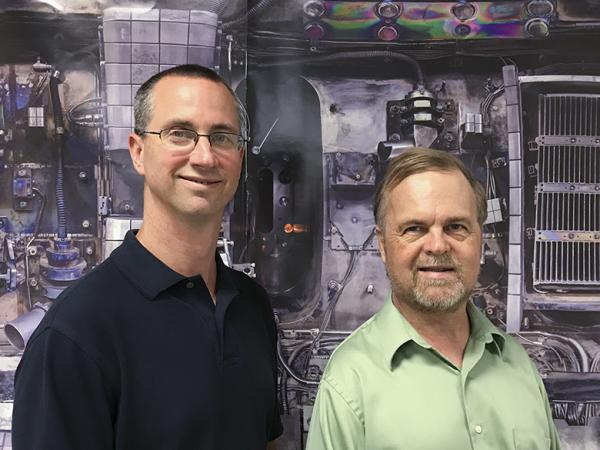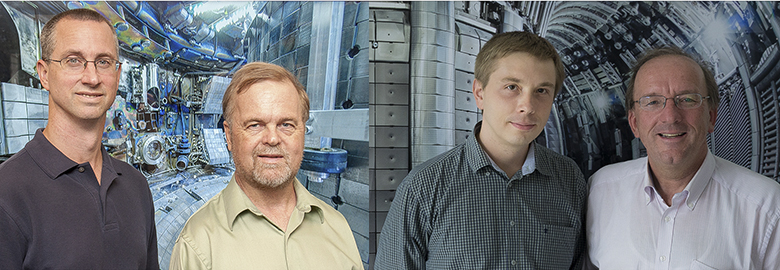
PSFC principal research scientists Stephen Wukitch (left) and John Wright collaborated with international partners to review a new approach for plasma heating.
Photo: Paul Rivenberg
PSFC researchers explore the possibilities of 3-ion heating
March 12, 2021
Principal research scientists at the MIT Plasma Science and Fusion Center, Dr. John Wright and Dr. Stephen Wukitch, have collaborated with international partners on a review paper summarizing research on a three-ion approach to plasma heating for magnetic fusion devices, a scenario for which they shared the American Physical Society (APS) Landau-Spitzer Award in 2018. Published in Physics of Plasma and featured on their website, “Physics and applications of three-ion ICRF scenarios for fusion research” became the journal’s most read paper.
One of the key fusion challenges is confining the energetic fusion product ions (or species) that must transfer their energy to the core plasma before they escape confinement. This new 3-ion heating scenario efficiently generates energies comparable to that of those produced by fusion and can be used to study energetic ion behavior in present day devices. The technique was originally explored on MIT’s Alcator C-Mod tokamak and the UK’s JET, the world’s largest tokamak. Since then additional experiments have been performed on ASDEX-Upgrade in Germany and JET that have significantly expanded the work.
The 3-ion heating method builds upon a 2-species technique known as minority heating, in which most of the plasma is made up of one species, but with a small amount of a second species that is heated. By using two ions to tune the plasma response to the heating of a third, the new method allows researchers greater flexibility to heat the third species for different uses. For example, it can be a source of energetic ions for stabilizing undesirable modes of the plasma, serve as proxy for fusion products to study their confinement, or direct the wave energy preferentially into heating the fuel ions for fusion.
Since the technique was recognized by APS, it has been demonstrated in fusion experiments beyond those originally run at MIT and JET. The method has been expanded, still using three ions, but with two of the species differing only in their energy content, allowing scenarios where so-called neutral beam heating can play a role. Recent experiments have explored how this scenario can be used to optimize heating in the upcoming ITER device, the burning plasma experiment being built in France. Further ITER-relevant experiments are planned this summer when JET launches a series of deuterium-tritium (D-T) experiments. It will also have some relevance for SPARC, a tokamak design being developed by MIT in association with Commonwealth Fusion Systems, where the three-ion scenario could provide energetic ions for predicting the confinement of fusion products in later D-T operations.
While the foundation of the three ion species has been established, Wright and Wukitch note that much remains to be learned on how this flexible heating method can be used in fusion plasmas.
“It provides an on-demand source of ions with energies of up to the order of fusion products that can be used to study confinement,’ says Wright, “but the more interesting potential is how an energetic ion source can be used to optimize plasma performance for fusion.”
 This composite photo shows Steven Wukitch and John Wright (left) in front of an interior shot of Alcator C-Mod, with Yevgen Kazakov and Jef Ongena, from Laboratory for Plasma Physics, in front of an interior shot of JET. The four researchers collaborated on these two devices to gain insights into plasma heating. Photo: Paul Rivenberg (MIT), S.Kirtz (IEK-4/Plasma Physics, Research Centre Jülich, Gemany)
This composite photo shows Steven Wukitch and John Wright (left) in front of an interior shot of Alcator C-Mod, with Yevgen Kazakov and Jef Ongena, from Laboratory for Plasma Physics, in front of an interior shot of JET. The four researchers collaborated on these two devices to gain insights into plasma heating. Photo: Paul Rivenberg (MIT), S.Kirtz (IEK-4/Plasma Physics, Research Centre Jülich, Gemany)
Wright and Wukitch acknowledge the work of the entire multi-institutional team, noting in particular the contributions of Dr. Yevgen Kazakov and Dr. Jef Ongena from the Laboratory for Plasma Physics of the Ecole Royale Militaire – Koninklijke Militarie School (LPP-ERM/KMS), who initiated this course of research and have been leading it.
Topics: Magnetic fusion energy, SPARC, Plasma heating & current drive